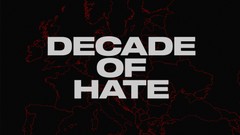Decade of Hate is a series that covers the dangerous rise of far-right movements across Europe over the past 10 years.
Advertisement
Visitors in Moscow inspect a military vehicle with the letter Z, which has become a symbol of support for the Russian invasion of Ukraine. Photo: NATALIA KOLESNIKOVA/AFP via Getty Images
Advertisement
Advertisement
Advertisement
Advertisement
